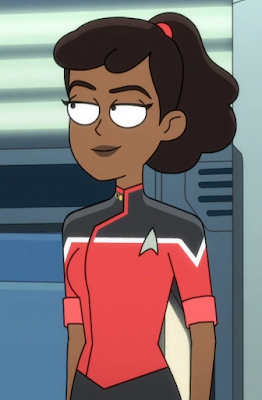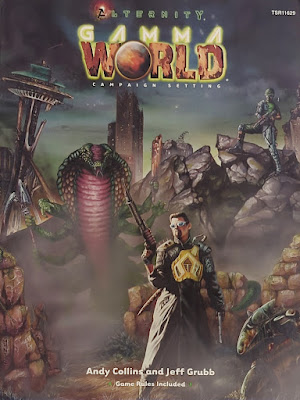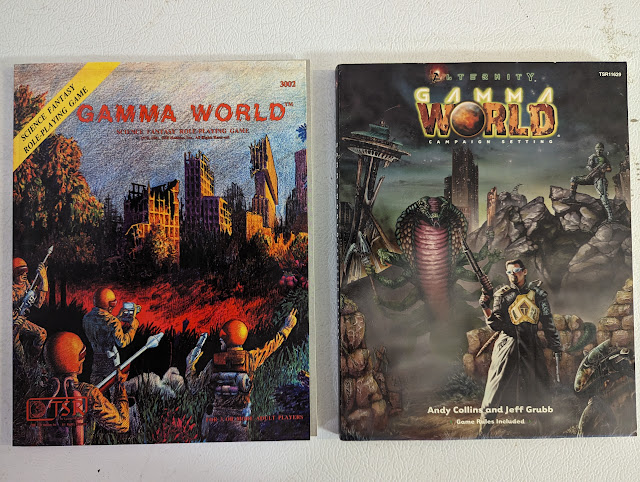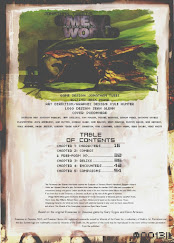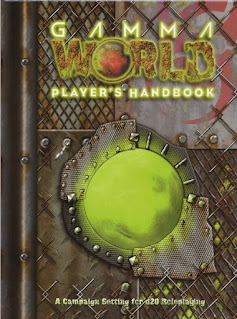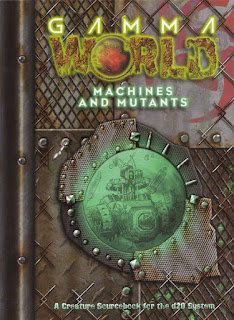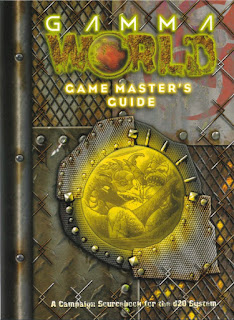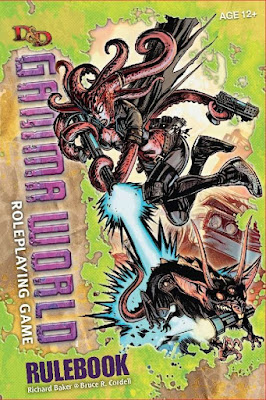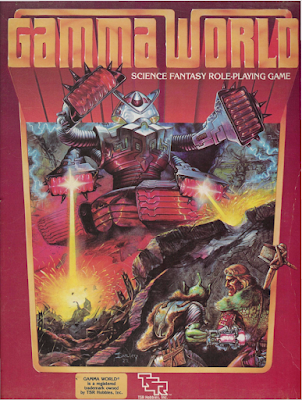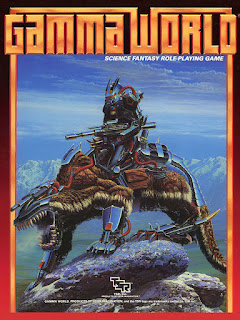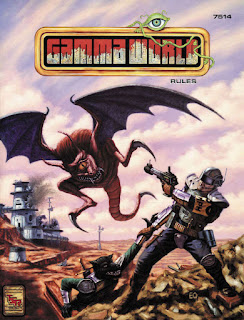The Other OSR: Runecairn: Wardensaga
 Ragnarök came to pass and the world as it was known came to an end. Yet the world did not end, it was only broken, the gods of the Aesir and the Vanir missing or dead, Jörmungandr dead and flensed, the Jotunn forced to flee back Jotunheim. Yet as broken as the world is, and as full of dread and danger as the Nine Realms are, there are heroes who would stand alone against the darkness, to defend villages against roving bandits, hunt a creature stealing children, reclaim a family cairn overcome by the dead, retrieve a great relic lost to the ages, broker peace between warring clans, protect a caravan passing through dangerous lands, and search lands old and new for secrets and mythical beasts. Such activities are dangerous, but these heroes are strong of heart and even when they die, they will find their way back to bonfires that warm the soul and give life and never dwindle—and even link the Nine Realms. A great hero’s failure is only temporary, until it isn’t. Until then, a hero can try again and again to overcome the danger he faces, to find another way now that he is forewarned.
Ragnarök came to pass and the world as it was known came to an end. Yet the world did not end, it was only broken, the gods of the Aesir and the Vanir missing or dead, Jörmungandr dead and flensed, the Jotunn forced to flee back Jotunheim. Yet as broken as the world is, and as full of dread and danger as the Nine Realms are, there are heroes who would stand alone against the darkness, to defend villages against roving bandits, hunt a creature stealing children, reclaim a family cairn overcome by the dead, retrieve a great relic lost to the ages, broker peace between warring clans, protect a caravan passing through dangerous lands, and search lands old and new for secrets and mythical beasts. Such activities are dangerous, but these heroes are strong of heart and even when they die, they will find their way back to bonfires that warm the soul and give life and never dwindle—and even link the Nine Realms. A great hero’s failure is only temporary, until it isn’t. Until then, a hero can try again and again to overcome the danger he faces, to find another way now that he is forewarned.Runecairn: Wardensaga is the most complete version of Runecairn, the Norse fantasy tabletop roleplaying game published By Odin’s Beard, collecting the Runecairn Core Rules, the adventure ‘Beneath the Broken Sword’, and Runecairn: Advanced Rules into one handsome volume. Like the publisher’s We Deal In Lead: A Weird West Wanders Game, it is inspired by minimalist Old School Renaissance roleplaying games such as Cairn, Into the Odd, and Knave. It is specifically designed to be played by a single Game Master—or Warden—and a single player. However, the advanced rules gives options for reducing the players to one and turning Runecairn: Wardensaga into a solo roleplaying game or increasing their numbers for a more traditional roleplaying game.
Runecairn: Wardensaga begins with general advice and then advice for Warden and player alike. It does this as a series of principles presented as bullet points. The general advice states that the Warden’s role is one of neutrality, that the roleplaying game is Classless—the abilities of an Adventurer relying on equipment and experiences, that the possibility of death is ever present though never without warning, that fiction comes before the dice, that an Adventurer has opportunities to grow through his experiences, and that the player should always be presented with choices. For the Warden these include design philosophy—that she is helpful and honest as conduit of information, the context and realism determine difficulty, that the world changes and sometimes changes because of what the Player Character does, the narrative should support the emerging story, that danger is everywhere and obvious, that the player and his character should always have and be presented with choices, and when all that fails, there is occasionally, just luck. For the player, the principles advise agency, exploration, talking, caution, planning, and ambition, and if one path leads to defeat, then he should look for an alternative path. For the most part, these will be familiar to adherents of the Old School Renaissance, but here are not elucidated upon, but rather kept short and to the point. Similarly, the world of Runecairn: Wardensaga has its own principles.
An Adventurer in Runecairn: Wardensaga has four abilities—Strength, Dexterity, Wits, and Spirit, rated between three and eighteen; Vigour and Vitality, which are rated between one and six; and Resilience which is a total of Vigour and Vitality. Vigour is the Adventurer’s self-determination, which Vitality is how hale and hearty he is. A player rolls dice for all of these, and can swap two of the abilities. The player then picks a Class. This can be Warrior, Skald, Scout, or Seer. Each Class provides a range of equipment and skills or special actions that will give the Player Character many of their initial abilities.
Gertrud
Warrior
Strength 17 Dexterity 15 Wits 11 Spirit 12
Vigour 6 Vitality 5 Resilience 11
Def 3
Linden Wood Shield (+1 Def), Chainmail (Bulky, Def 2), Bearded Axe (d8), Ash Wood Spear (d6, 20’), Memento of Defeat, (Free Slots: 4)
Skills: Block (Shield), Parry (Axe), Disarm (Axe), Hack (Axe), Thrust (Spear)
Mechanically, Runecairn: Wardensaga is straightforward. When a player wants his Adventurer to act or react-and it is dramatically appropriate—he rolls a save versus either Strength, Dexterity, Wits, or Spirit, needing to roll equal to or lower than the value. A one always succeeds and a twenty always fails. Standard rules are used for advantage and disadvantage, and can apply to damage as well as standard actions.
In terms of combat, Runecairn: Wardensaga uses the same core mechanic, but in terms of rolling dice, combat in the roleplaying game is all about damage and reactions. Fundamentally, every attack made by an attacker will hit the defender and inflict damage. That is, unless the defender can do something as a reaction. Every Adventurer can ‘Roll’ away from the attack or ‘Withdraw’ from the combat, but each Class adds its own options in terms of Reactions. These require ‘Key’ items, pieces of equipment, that without, the Adventurer cannot perform the Reaction. For example, the Scout’s Key item is a pair of hunting knives. These are light enough that the Scout can perform a ‘Dash’ as a Reaction, which requires a save versus his Dexterity, the Scout able to avoid all damage if successful or impairing it and reducing it to a four-sided die if it is unsuccessful. Attack actions also require an item of equipment and increase the amount of damage inflicted or another effect. For example, the Seer Class has the ‘Clobber’ action. This requires a staff and has the Seer smashing a defender over the head with his staff, granting the Seer advantage for the damage roll, and the defender being forced to roll a save versus Strength or be dazed. Many of the actions and Reactions force the Adventurer to suffer ‘Fatigue’. Each point of Fatigue fills a slot in the Adventurer’s Inventory.
One damage is suffered, the ‘Def’ or Defence value, reduces the amount of damage suffered. Both Classes and monsters and NPCs have a base ‘Def’ and this can be augmented by any armour worn or shield carried. Damage is then deducted from Resilience. If an Adventurer’s Resilience is reduced to exactly zero, he will receive an Omen, a message from the spirits, or gods, or… which can be good or bad. If reduced below zero, damage reduces Strength and counts as a critical strike. This requires a save versus critical damage on Strength, and if failed, the defender dies.
For example, as Gertrude struggles through the last of a snowstorm to get to the next village, she hears yells and screams from up ahead. Over the rise, she sees a caravan which has been ambushed during the storm. It is in disarray as several figures fight the surviving guards and others drag off merchants. Gertrude spots two of the rough-looking fellows attempting to abduct an old woman. Unlimbering her Linden Wood Shield and readying her bearded axe, she charges down the hill. The Warden rules that since the battlefield is noisy and the old woman is screaming, neither of the cultists will spot her charging down the hill and will grant her Advantage on the damage roll. This means that Gertrude’s player will rolling two eight-sided dice instead of one and taking the best result. Gertrude’s player rolls a five and an eight. He chooses the latter and inflicts eight points of damage. The Cultist has a Def of one, reducing the damage he is about to suffer by one to seven. However, the Cultist only has Resilience of six, so it is reduced to zero and the Cultist takes a point of damage to his Strength. It also means that the Warden has to make a Critical Damage save. The Warden rolls against the Cultist’s Strength of ten and rolls a sixteen! The Cultist yelps at the sudden blow and drops dead… At this point, it triggers a special ability which means that when the Cultist dies, a black tentacle bursts out of him and inflicts damage on the nearest person. This requires a roll of one on a twenty-sided die. The Warden rolls seven, so nothing happens.
The other Cultist looks round in surprise. He reacts by throwing the old woman down and drawing his seax, advances on Gertrude. He stabs at the mighty warrior and rolls six for the damage. Gertrude has a high enough to stop a lot of this damage, but his player decides on a Parry Reaction. This enables Gertrude to deflect the attack and riposte with advantage on the damage roll. Gertrude’s player rolls fourteen, which is under Gertrude’s Strength. Gertrude smashes the seax stab aside and the Cultist suffers enough damage to reduce his Resilience to zero, but not inflict any damage to his Strength. The Cultist screams in pain. This attracts the attention of the other cultists attacking the caravan. They stop what they are doing and move to take down their attacker. She will make a worthy sacrifice.Two of the Classes—the Skald and the Seer—are capable of casting various forms of magic. These are Runestones and Sagas. Runestones are polished stones into which spells are inscribed, whilst Sagas are memorised tales that are recited to channel the power of the gods. Both Runestones and Sagas take up an Inventory Slot in total and when either a Runestone or a Saga inflicts damage, it bypasses non-magical armour. There is a decent list of spells for the Seer, such as Cloak of Knives or Spectacle, as well as one for the Skald like Laughter or Sense Evil.
As the mighty warrioress comes to her aid and attacks the cultists who would have kidnapped her, the old woman, Tove, finds herself thrown into the snow. She is now free to act, and as Skald, she reaches into the folds of her tunic to pull out her Runic Focus. Concentrating on the key item, she recalls the story in which Thor called down the power of lightning on his enemies. With a crackle of energy, a dagger of lightning appears in her hand. From where she lies, she throws it at the Cultist still standing in front of the unknown warrioress. This inflicts three damage, reduced by one for the Cultist’s ‘Def’. This means the Cultist suffers Strength damage and triggers a Critical Damage save. The Warden rolls eleven for the Cultist, which means that with a zap, the Cultist is blown off his feet. The Warden rolls for the Cultist’s post-death ability. This time she rolls a one and a black tentacle emerges from the dead Cultist and inflicts a six-sided die’s worth of damage on Gertrude! If an Adventurer dies, it does not necessarily mean that play is over. The Adventurer simply reawakens at the last Bonfire he rested at. He loses all Souls found—Souls are remnants of the power of the gods scattered and hidden across the Nine Realms, that if returned to a Bonfire whilst alive can be used to imbue an Adventurer with power and improve his abilities and Vitality—and has his Strength and Resilience restored to full. However, when this happens, it also reduces his Vigour by one. If his Vigour is reduced to zero in this fashion, the Adventurer truly dies and rises as a Shade… Lastly, any enemy that the Adventurer killed before dying is also returned to life!
This is the extent of Runecairn in terms of its basic rules. What is interesting about Runecairn: Wardensaga is that it shifts what would be the inherent abilities of a Player Character because said Player Character has a Class in another roleplaying game from the internal to external. Much of what a Player Character can do is down to the equipment that he carries and packs into his inventory, and many of them enable the use of skills. What that means is that an Adventurer in Runecairn: Wardensaga could snatch up a spear and carry a ‘Thrust’ attack as per the Warrior Class, enabling him to lunge forward ten feet and make an attack, but suffering from fatigue in return, or after obtaining a Runic Focus, learn spells as can a Skald. In addition to finding Souls and spells, an Adventurer can also find Relics and Rings. Relics are items imbued with magic or spells, often one-use items, which when used do not inflict Fatigue, and sometimes can be recharged. For example, a Skull Beacon, a charred and crumbling skull with faintly glimmering eye sockets, which glows brightly when held. It can be used to light up and area, but only once. To recharge it, it needs to be burned on a roaring bonfire. Rings typically grant a better benefit, but always at some cost. For example, the Iron Ring is wrought of dense metal grants a point of Defence, but at a loss of Speed.
The Advanced Rules of Runecairn: Wardensaga provide two extra Classes, alternate ways of playing the roleplaying game, and a Delve Generator. The two extra Classes are the Berserker and the Pyre. The former is a warrior who calls upon his animal spirit to fight with great ferocity, whilst the latter draws upon fire to burn his enemies and even shield against their attacks. The first of the alternate methods of play is solo play. This suggests playing Runecairn: Wardensaga as a Journalling game, suggesting that the player use an ‘Oracle’ as a means to draw meaning from the randomness of play, such as that created using the Delve Generator. This ‘Oracle’ can be a Tarot deck, but the guidance for solo play in the Advanced Rules of Runecairn: Wardensaga provides a set of tables to roll upon. The co-operative play gives a way of bringing another player into a session, the Adventurer using an effigy stone at a bonfire to summon a fallen hero—from either the past or the future—who will fight alongside the Adventurer, until one of them dies. Conversely, the Adventurer might face a ‘black fetch’ instead of a fallen hero, intent of stripping him of his humanity and vigour. The ‘black fetch’ can be run as a normal NPC by the Warden, or if both players do not object to the situation, by another player, setting up an adversarial situation. Alternatively, the ‘black fetch’ might actually be a fallen hero who believes the Adventurer to be the ‘black fetch’!
The Delve Generator creates locations for play in Runecairn: Wardensaga. This includes locations such as cairn or stronghold, objectives such as infiltrating the mercenary group at a stronghold and convincing its members to join the Adventurer or hunting a cairn for the rock troll that killed the adventurer’s family is hiding out in the family tomb. An extensive set of tables provides encounters within these locations, NPC reactions and actions, and a countdown mechanic which determines how close the Adventurer is to his objective after each encounter. Thus, the Adventurer need not explore the whole of the location to achieve his objective. The process is neatly handled through a flow chart that makes the solo play proceed with ease.
Penultimately, Runecairn: Wardensaga provides a complete delve, ‘Beneath the Broken Sword’. This is designed as an introductory adventure which showcases how to play and how the Adventurer lives and dies. It begins with the Adventurer waking up not know where he is and what he should possess, so the first part is really looking for both, though the inevitable death within the first few locations will teach the player the transient nature of life and death in the roleplaying game and then reinforce the importance of the Adventurer’s possessions as they really are key to his survival. Lastly, the appendices consist of a short, but useful bestiary, and some player options as well as a pronunciation guide.
Physically, Runecairn: Wardensaga is well presented and the artwork is excellent. However, the writing does feel succinct in places, leaving the reader wanting a little clearer explanation. However, there is a good example of Adventurer and a good example of combat. Both do a good job of showing how the roleplaying game works. If there is anything missing from the pages of Runecairn: Wardensaga, it is details of the wider world, of the Nine Realms, which the Warden will have to develop. Another issue is that there is no differentiation within each Class, so that the only difference one Warrior and another is their core abilities. That said, Runecairn: Wardensaga is not designed for that style of play where these are multiple players. Nevertheless, when there are two players involved, they should ideally have their Adventurers each be of a different Class.
Runecairn: Wardensagaa is the complete version of Runecairn, containing everything needed to play, including a beginning scenario, and then more to play further, whether that is just one player and the Warden, as is standard, solo play, or more players. There is a fantastically brutal dynamism to the play of Runecairn: Wardensaga, combined with a strong player agency that the Warden is encouraged to support through the roleplaying game’s principles. In particular, the thrust back and forth of combat is desperate and gruelling, a player whose Adventurer has his equipment, always having choices in terms of how he attacks and he reacts. This reliance upon equipment emphasises the power of these choices and makes the Adventurer feel mortal—even though this is not the case as death returns him to the last bonfire—rather than like some fantasy superhero. Yet the heroic aspect of Runecairn: Wardensaga means that the Adventurer can return from the dead, to come back with the knowledge of what killed him and perhaps be better prepared for the next attempt.
Above all, Runecairn: Wardensaga is a really enticing roleplaying game for two that gives the Warden a set of solid tools with which to create the situations and delves for the Adventurer to get involved in, whilst for the player, there are some great Adventurers to play and bring to life and use their skills, and together the means to explore a broken world. Ultimately, Runecairn: Wardensaga is like a computer game in its one-on-one play-style, but its post-Ragnarök action has all the advantages of a tabletop roleplaying game—player agency, the varied and more reactive world created by the Warden, and the fierce and feisty actions, reactions, and decisions of the Adventurer.
—oOo—
By Odin’s Beard will be at UK Games Expo which takes place on Friday, May 31st to Sunday June 2nd, 2024.








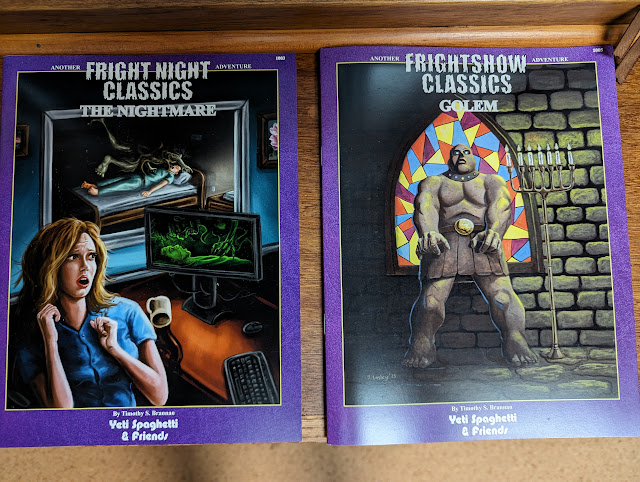










_trailer_-_Brides.png)
